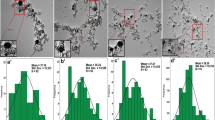Abstract
Pulsed Laser Ablation in Liquid PLAL is one of the most effective methods for creating nanoparticles material. The PLAL process was used to make AgO nanoparticles, in which the silver target was submerged in ultrapure water UPW and then irradiated with an Nd: YAG laser (Q-switched, 1064 nm, 6 ns pulse duration). The laser beam was concentrated near the silver surface throughout this operation. The effects of different incoming laser pulse intensities (50, 250, 500, 750) mJ were investigated on the particle size of nanoparticles generated via laser irradiation. Nanoparticles in the nano solution were characterized through Atomic Force Microscope AFM, Ultraviolet-Visible UV-VIS test, PH measurement, and Electrical Conductivity EC test. The smallest particle size was produced with (50) mJ laser pulse energy. A new model is derived to understand the electrical conductivity results at different sizes including nanoscale. The new model brought a new factor proportional to the third degree of grain size. Despite the experimentally yielded low value compared with other factors, it has a valuable role in interpreting the conductivity results at different grain sizes.









Similar content being viewed by others
Data Availability
Not applicable.
Code Availability
Not applicable.
References
Edison, T.J.I., Sethuraman, M.G.: Instant green synthesis of silver nanoparticles using Terminalia chebula fruit extract and evaluation of their catalytic activity on reduction of methylene blue. Process. Biochem. 47, 1351–1357 (2012)
Parameshwaran, R., Kalaiselvam, S., Jayavel, R.: Green synthesis of silver nanoparticles using Beta vulgaris: role of process conditions on size distribution and surface structure. Mater. Chem. Phys. 140, 135–147 (2013)
Alagar, M., Theivasanthi, T., Kubera Raja, A.: Chemical synthesis of Nano-sized particles of Lead oxide and their characterization studies. J. Appl. Sci. 12, 398–401 (2012)
Al-Douri, Y., Al-Samarai, R.A., Abdulateef, S.A., Odeh, A.A., Badi, N., Voon, C.H.: Nanosecond pulsed laser ablation to synthesize GaO colloidal nanoparticles: Optical and structural properties. Optik (Stuttg). 178, 337–342 (2019)
Al-Douri, Y.: 3 - nanosecond pulsed laser ablation to synthesize ternary alloy colloidal nanoparticles metal oxides. In: Thomas, S. (ed.) A tresa sunny and P B T-C M O N Velayudhan, pp 25–38. Elsevier. (2020)
Al-Douri, Y., Abdulateef, S.A., Odeh, A.A., Voon, C.H., Badi, N.: GaNO colloidal nanoparticles synthesis by nanosecond pulsed laser ablation: Laser fluence dependent optical absorption and structural properties. Powder Technol. 320, 457–461 (2017)
Makarov, V.V., Love, A.J., Sinitsyna, O.V., Makarova, S.S., Yaminsky, I.V., Taliansky, M.E., Kalinina, N.O.: “Green” nanotechnologies: synthesis of metal nanoparticles using plants. Acta Nat. (англоязычная версия). 6, (2014)
Delma, B., Vijila, B., Rajan, M.J.: Green synthesis of copper and lead nanoparticles using ZingiberOfficinale stemextract. Int. J. Sci. Res. Publ. 6, 134–137 (2016)
Elango, G., Roopan, S.M.: Green synthesis, spectroscopic investigation and photocatalytic activity of lead nanoparticles Spectrochim. Acta Part A Mol Biomol Spectrosc. 139, 367–373 (2015)
Kumar, D., Jain, A.: Green chemistry approach : synthesis. Characteriz. Therm. Stud. Nanocompos. Lead Oxide Nanopart. 8, 86–93 (2016)
Parashar, U.K., Kumar, V., Bera, T., Saxena, P.S., Nath, G., Srivastava, S.K., Giri, R., Srivastava, A.: Study of mechanism of enhanced antibacterial activity by green synthesis of silver nanoparticles. Nanotechnology. 22, 415104 (2011)
Assar, N.H., Hamuoda, H.M.: Colloidal silver as a new antimicrobial agent. Int. J. Microbiol. Res. 1, 33–36 (2010)
Shrivastava, S., Bera, T., Roy, A., Singh, G., Ramachandrarao, P., Dash, D.: Characterization of enhanced antibacterial effects of novel silver nanoparticles. Nanotechnology. 18, 225103 (2007)
Hu, T.L., Hwa, J.Z., Chang, W.F., Wu, J.J.: Anti-bacterial study using nano silver-doped high density polyethylene pipe. Sustain Environ. Res. 22, 153–158 (2012)
Dutta, R.K., Nenavathu, B.P., Gangishetty, M.K., Reddy, A.V.R.: Studies on antibacterial activity of ZnO nanoparticles by ROS induced lipid peroxidation. Colloids Surf. B: Biointerfaces. 94, 143–150 (2012)
Selvam, S., Rajiv Gandhi, R., Suresh, J., Gowri, S., Ravikumar, S., Sundrarajan, M.: Antibacterial effect of novel synthesized sulfated β-cyclodextrin crosslinked cotton fabric and its improved antibacterial activities with ZnO, TiO2 and ag nanoparticles coating. Int. J. Pharm. 434, 366–374 (2012)
Matthews, L., Kanwar, R.K., Zhou, S., Punj, V., Kanwar, J.R.: Applications of nanomedicine in antibacterial medical therapeutics and diagnostics. Open Trop. Med. J. 3, 1–9 (2010)
Lara, H.H., Ayala-Núñez, N.V., Ixtepan Turrent, L.D.C., Rodríguez Padilla, C.: Bactericidal effect of silver nanoparticles against multidrug-resistant bacteria. World J. Microbiol. Biotechnol. 26, 615–621 (2010)
Nabipour, Y.S., Rostamzad, A.: Comparing the antimicrobial effects of silver and copper nanoparticles against pathogenic and resistant bacteria of Klebsiella pneumonia, Pseudomonas aeruginosa and Staphylococcus aureus. Cumhur. Üniv. Fen. Edeb. Fakültesi Fen Bilim. Derg. 36, 2541–2546 (2015)
Hassan, M.S., Taha, Z.A., Rasheed, B.G.: Synthesis and modeling of temperature distribution for nanoparticles produced using Nd:YAG lasers ed O Millo. J. Nanotechnol. 2016, 8560490 (2016)
Avicenna, S., Nurhasanah, I., Khumaeni, A.: Synthesis of colloidal silver nanoparticles in various liquid media using pulse laser ablation method and its antibacterial properties. Indones J Chem. 21, 761–768 (2021)
Rashid, S.N., Aadim, K.A., Jasim, A.S.: Silver nanoparticles synthesized by Nd: YAG laser ablation technique: characterization and antibacterial activity. Karbala Int. J. Mod. Sci. 8, 71–82 (2022)
Nafil, R.Q., Majeed, M.S., Hashim, E.T.: Improvement electrolysis of water efficiency for hydrogen production using stainless steel nanoparticles synthesized by laser technique. J. Mech. Eng. Res. Dev. 42, 20–22 (2019)
Majeed, M.S., Hamad, T.K., Hashim, E.T.: ZnO nanoparticle synthesis using ND: YAG laser for increasing hydrogen fuel cell performance. Int. J. Mech. Prod. Eng. Res. Dev. 8, 497–506 (2018)
Fadhil, S.A., Alrawi, A.H., Azeez, J.H., Hassan, M.A.: A new multiscale model to describe a modified Hall-Petch relation at different scales for nano and micro materials. AIP Proc. 1948, 020006 (2018)
Fadhil, S.A., Azeez, J.H., Whahaeb, A.F.: Solving the instantaneous response paradox of entangled particles using the time of events theory. Eur. Phys. J. Plus. 129, 23 (2014)
Fadhil, S.A., Azeez, J.H., Hassan, M.A.: Derivation of a new multiscale model: I. derivation of the model for the atomic, molecular and nano material scales. Indian J. Phys. 95, 209–217 (2021)
Fadhil, S.A., Hassan, M.A., Azeez, J.H., Majeed, M.S.: Derivation of a new multiscale model: II. Deriving a modified hall-Petch relation from the multiscale model and testing it for nano, micro, and macro materials. IOP Conf. Ser. Mater. Sci. Eng. 881, 012098 (2020)
Acknowledgments
This work was supported by Al-Nahrain Nanorenewable Energy Research Center, Al-Nahrain University.
Funding
funded by Al-Nahrain Nanorenewable Energy Research Center, Al-Nahrain University.
Author information
Authors and Affiliations
Contributions
Not applicable.
Corresponding author
Ethics declarations
Ethics Approval
Not applicable.
Consent to Participate
Not applicable.
Consent for Publication
Not applicable.
Conflicts of Interest/Competing Interests
Not applicable.
Additional information
Publisher’s Note
Springer Nature remains neutral with regard to jurisdictional claims in published maps and institutional affiliations.
Rights and permissions
About this article
Cite this article
Majeed, M.S., Hassan, S.M. & Fadhil, S.A. AgO Nanoparticles Synthesis by Different Nd:YAG Laser Pulse Energies. Lasers Manuf. Mater. Process. 9, 228–240 (2022). https://doi.org/10.1007/s40516-022-00174-6
Accepted:
Published:
Issue Date:
DOI: https://doi.org/10.1007/s40516-022-00174-6




